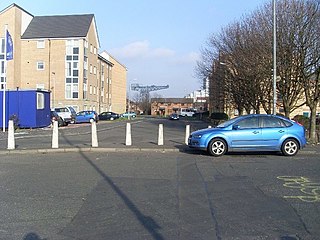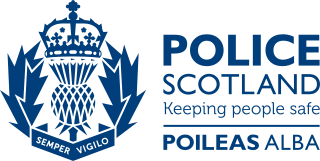
The Terrorism Act 2000 is the first of a number of general Terrorism Acts passed by the Parliament of the United Kingdom. It superseded and repealed the Prevention of Terrorism Act 1989 and the Northern Ireland Act 1996. It also replaced parts of the Criminal Justice Act 1998. The powers it provides the police have been controversial, leading to noted cases of alleged abuse, and to legal challenges in British and European courts. The stop-and-search powers under section 44 of the Act have been ruled illegal by the European Court of Human Rights.

Partick is an area of Glasgow on the north bank of the River Clyde, just across from Govan. To the west lies Whiteinch, to the east Yorkhill and Kelvingrove Park, and to the north Broomhill, Hyndland, Dowanhill, Hillhead, areas which form part of the West End of Glasgow. Partick was a Police burgh from 1852 until 1912 when it was incorporated into the city. Partick is the area of the city most connected with the Highlands, and several Gaelic agencies, such as the Gaelic Books Council are located in the area. Some ATMs in the area display Gaelic.
Red Clydeside was the era of political radicalism in Glasgow, Scotland, and areas around the city, on the banks of the River Clyde, such as Clydebank, Greenock, Dumbarton and Paisley, from the 1910s until the early 1930s. Red Clydeside is a significant part of the history of the labour movement in Britain as a whole, and Scotland in particular.

Thomas Sheridan is a Scottish politician who served as convenor of Solidarity from 2019 to 2021. He previously served as convenor of the Scottish Socialist Party (SSP) from 1998 to 2004 and as co-convenor of Solidarity from 2006 to 2016. He was a Member of the Scottish Parliament (MSP) for the Glasgow region from 1999 to 2007.

The Glasgow Subway is an underground light metro system in Glasgow, Scotland. Opened on 14 December 1896, it is the third-oldest underground rail transit system in the world after the London Underground and the Budapest Metro. It is also one of the very few railways in the world with a track running gauge of 4 ft. Originally a cable railway, the subway was later electrified, but the double-track circular line was never expanded. The line was originally known as the Glasgow District Subway, and was thus the first mass transit system to be known as a "subway"; it was later renamed Glasgow Subway Railway. In 1936 it was renamed the Glasgow Underground. Despite this rebranding, many Glaswegians continued to refer to the network as "the Subway". In 2003, the name "Subway" was officially readopted by its operator, the Strathclyde Partnership for Transport (SPT).

Craigton is a residential suburb in the southwest of the city of Glasgow, Scotland. Located approximately three miles from the city centre, it is bordered by Bellahouston Park to the south and Halfway to the west, with Cardonald beyond.

Strathclyde Police was the territorial police force responsible for the Scottish council areas of Argyll and Bute, Glasgow City, East Ayrshire, East Dunbartonshire, East Renfrewshire, Inverclyde, North Ayrshire, North Lanarkshire, Renfrewshire, South Ayrshire, South Lanarkshire and West Dunbartonshire between 1975 and 2013. The Police Authority contained members from each of these authorities.

Kinning Park is a southern suburb of Glasgow, Scotland. It was formerly a separate police burgh between 1871 and 1905 before being absorbed by the city. In 1897, it had a population of 14,326.

Govan Old Parish Church is a former parish church serving Govan in Glasgow from the 5th or 6th century AD until 2007. In that year, the Church of Scotland united the two Govan congregations with Linthouse and established the parish church at Govan Cross, making Govan Old redundant.
Terrorism in Australia deals with terrorist acts in Australia as well as steps taken by the Australian government to counter the threat of terrorism. In 2004 the Australian government has identified transnational terrorism as also a threat to Australia and to Australian citizens overseas. Australia has experienced acts of modern terrorism since the 1960s, while the federal parliament, since the 1970s, has enacted legislation seeking to target terrorism.

On 29 June 2007, two car bombs in London were discovered and disabled before they could be detonated. The first device was left near the Tiger Tiger nightclub in Haymarket at around 01:30, and the second was left in Cockspur Street, located in close proximity to the nightclub.

The Glasgow Airport attack was a terrorist ramming attack which occurred on 30 June 2007, at 15:11 BST, when a dark green Jeep Cherokee loaded with propane canisters was driven at the glass doors of the Glasgow Airport terminal and set ablaze. The car's driver was severely burnt in the ensuing fire, and five members of the public were injured, none seriously. Some injuries were sustained by those assisting the police in detaining the occupants. A close link was quickly established to the 2007 London car bombs the previous day.

Mohammed Atif Siddique is a Scottish prisoner who was found guilty, but later cleared on appeal, of one of his convictions "collecting terrorist-related information, setting up websites...and circulating inflammatory terrorist publications", resulting in a sentence of eight years' imprisonment. His defence has consistently been that he was a curious 20-year-old youth, still living with his parents, who was "looking for answers on the internet". One of his convictions was quashed on appeal on 29 January 2010. He remains a convicted terrorist.

In the United States, a common definition of terrorism is the systematic or threatened use of violence in order to create a general climate of fear to intimidate a population or government and thereby effect political, religious, or ideological change. This article serves as a list and a compilation of acts of terrorism, attempts to commit acts of terrorism, and other such items which pertain to terrorist activities which are engaged in by non-state actors or spies who are acting in the interests of state actors or persons who are acting without the approval of foreign governments within the domestic borders of the United States.
CONTEST is the United Kingdom's counter-terrorism strategy, first developed by Sir David Omand and the Home Office in early 2003 as the immediate response to 9/11, and a revised version was made public in 2006. Further revisions were published on 24 March 2009, 11 July 2011 and June 2018. An Annual Report on the implementation of CONTEST was released in March 2010 and in April 2014. The aim of the strategy is "to reduce the risk to the UK and its interests overseas from terrorism so that people can go about their lives freely and with confidence." The success of this strategy is not linked to total elimination of the terrorist threat, but to reducing the threat sufficiently to allow the citizens a normal life free from fear.

Police Scotland, officially the Police Service of Scotland, is the national police force of Scotland. It was formed in 2013, through the merging of eight regional police forces in Scotland, as well as the specialist services of the Scottish Police Services Authority, including the Scottish Crime and Drug Enforcement Agency. Although not formally absorbing it, the merger also resulted in the winding down of the Association of Chief Police Officers in Scotland.

National Action is a British far-right fascist and neo-Nazi terrorist organisation based in Warrington. Founded in 2013, the group is secretive, and has rules to prevent members from talking about it openly. It has been a proscribed organisation in the United Kingdom under the Terrorism Act 2000 since 16 December 2016, the first far-right group to be proscribed since the Second World War. In March 2017, an undercover investigation by ITV found that its members were still meeting in secret. It is believed that after its proscription, National Action organised itself in a similar way to the also-banned Salafi jihadist Al-Muhajiroun network.

Project Servator police deployments were originally introduced by the City of London Police in February 2014 as "New policing tactics to deter and detect criminal and terrorist activity, as well as to reassure the general public. " Project Servator has since been adopted by British Transport Police, Police Scotland, Essex Police, Ministry of Defence Police the Civil Nuclear Constabulary and the Metropolitan Police. The police have used Project Servator tactics in London, on the national rail network and at the 2014 Commonwealth Games in Glasgow, V Festival and shopping centres.

Govan Municipal Buildings is a former local authority building on Orkney Street in Govan, Scotland. The building, which was the meeting place of the local burgh council in the 19th century, is a Category B listed building.
















